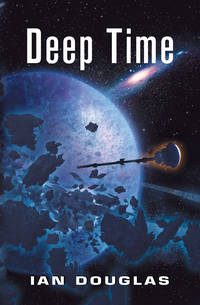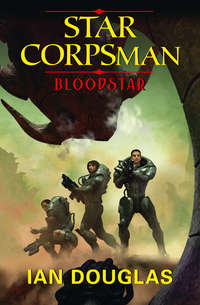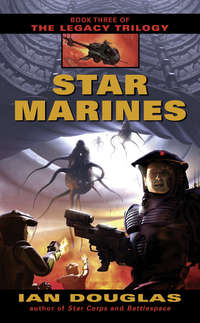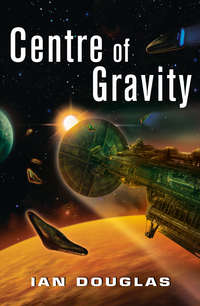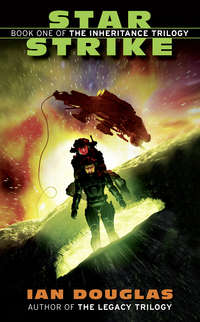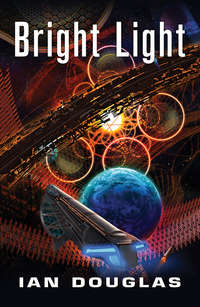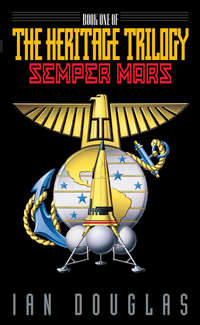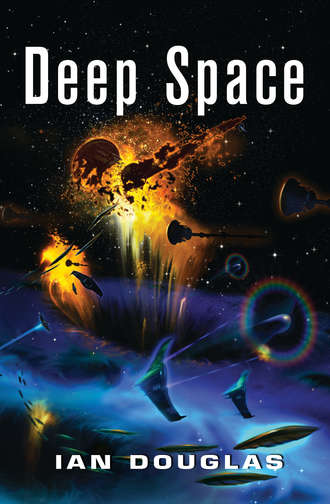
Полная версия
Deep Space
It didn’t help, Koenig thought as he felt the return-flow of data flooding into his brain, that computer intelligence was of a vastly different type than most known organic minds—humans and the Agletsch, for instance. It was difficult to pinpoint exactly how it was different … but the machine network’s thoughts, quick, all-encompassing, and fluid, were unlike those of humans both in their precision and in their scope. It seemed as though Konstantin was considering everything about each question, every angle, every possibility, before it spoke.
A window opened in Koenig’s mind, and he saw Konstantin’s avatar.
White-haired, balding, with a small, square beard at his chin and antique pince-nez, the image of Konstantin Tsiolkovsky was anachronistically seated within a data-feed donut, a circular workstation ringed with large viewscreens, ghostly virtual control panels, and floating display monitors. The real Tsiolkovsky, Koenig knew, had been a hermit who’d spent most of his life in a log cabin on the outskirts of Kaluga, in Russia, when he wasn’t teaching high school mathematics in a nearby school.
He’d also been one of the twentieth century’s foremost technophilosophers, an advocate of space colonization who’d believed that Humankind one day would spread throughout the galaxy, perfecting itself as humans became immortal. Eventually, Tsiolkovsky had become known as the father of spaceflight, and had been the first person to describe how a space elevator might work.
The image turned in its seat, peering querulously at Koenig over the top of its pince-nez. “So, the president of North America,” it said, speaking English. “Until you Americans learn to take a truly global view, there is little I can do for you.”
“I am not here on behalf of just Americans, Konstantin,” Koenig replied. “The decisions I must make have … a more-than-global significance. They will affect all of Humankind.”
As always, there was a hesitation, a two-and-a-half second pause as the signal crawled from Earth to the moon, and the response crawled back.
“Indeed.” Was that a twinkle in the old man’s eye? It was there and gone so swiftly Koenig couldn’t be certain he’d really seen it. The illusion of life, he had to admit, was perfect.
Koenig became aware of a low-voiced susurration in the background, a sea of many voices, none distinct enough to make out. The display monitors surrounding Tsiolkovsky, he saw, showed a dozen different scenes from around the world and out in space. He recognized a Senate debate in progress on the floor of the Neocapitol Tower in Columbus, and the face of Ilse Roettgen, the president of the Confederation Senate, delivering a speech in the Legislators’ Grand Hall of the Ad Astra Government Complex in Geneva. There was an external view of a large, rotating nanufactory in synchorbit, and another of a freighter landing at Crisium Starport. Papess Maria II spoke to an enthusiastic crowd packed into St. Peter’s from her apartment balcony, while under a cold, white moon, armored Chinese troops and hunter-killer robots hunted insurgents in a Philippine jungle. The Washington Monument rose from flooded swamps interrupted here and there by the white and gray of vine-shrouded granite buildings, but in the distance, hovercranes floated above the mangrove forest, where the domed Capitol Building, after more than three hundred years, once again stood on dry land.
The monitor images were flickering from one to another in rapid succession, thousands, perhaps, each appearing for a few seconds before being replaced by something else. The whisper in the background was a blend of countless voices emerging from the virtual sea.
“Kazakhstan is approaching a crisis point,” Konstantin said in a far-off voice, seemingly distracted. One monitor briefly showed the rusted hulk of a robotic harvester half submerged in blowing sand. “They still rely primarily on organic crops rather than agronanufactories, but increasing desertification, especially in the West, has sharply reduced the area of grain-growing regions and make famine likely. I estimate an eighty percent probability that something in excess of fifteen million humans will die of starvation and disease within the next five years.
“The Chinese Hegemony, on the other hand, has surplus agronanufactory capabilities, but, seeking a buffer against Russia, will demand political concessions from Astana in the East—in particular the arcologies at Almaty, the largest Kazakh population center.
“A serious confrontation is developing between your United States of North America and the Earth Confederation government … particularly with members of the European Union. The Verrazano Seacrete project is nearing completion, making possible the full-scale renovation of the Manhattan Ruins. The Potomac Dam has made possible the draining of the Washington, D.C., ruins, where approximately forty percent of the submerged land has already been reclaimed.
“Geneva, however, is arguing that since the North American government renounced all claim and control over the Periphery centuries ago, control and ownership now legally reverts to the planetary government, under laws designed to allow the annexation of failed states as legal wards of Geneva. More worrying still, there is currently a bill within the Geneva Senate calling for an invocation of the Confederation’s Military First Right, which would put the USNA Navy under the direct control of Geneva. I estimate a thirty percent chance of armed conflict breaking out between the United States of North America and the Earth Confederation. If such a conflict escalates beyond regional clashes, and if neither party backs down, the exchange could become a full-blown civil war fought in space as well as on Earth, leading to the deaths of hundreds of millions of people.”
“And why are you telling me all of this, Konstantin?”
Again, that hesitation. It made the old-man avatar seem more human. “To be certain that you understand the complexity of the global balance at this point in time. Humans are not rational creatures when it comes to either politics or to claims of national sovereignty. They are not rational in terms of perceived external threat. The destruction of the Endeavor can only further complicate matters, and could easily lead to a full break between the USNA and Geneva, with consequences that would threaten human civilization.”
“I understand that. I also understand that there are no easy solutions.” He wondered, though, if Konstantin grasped that fact.
“If the Chinese hegemony were to donate nanufactured food to Kazakhstan as a humanitarian gesture, without demanding recompense in land and population centers, famine would be averted without forcing a political crisis. If, rather, Kazakhstan cedes control of her eastern provinces to the hegemony, including the city of Almaty, famine will again be averted, since the feeding of the citizens of Almaty would then be the responsibility of the Hegemony government. Unfortunately, neither outcome is likely.” Konstantin paused, a distinctly human affectation. “I despair, sometimes, of you humans. Your passions may well destroy you.”
“My concern right now is that we might be destroyed by the Sh’daar.”
“A valid concern.”
“The Sh’daar seemed worried about the possibility that humans could defeat or destroy them by somehow accessing the past. Their past. I’d like you to tell me if this is possible, and how we might bring it to pass.”
“Ah,” Konstantin said. “The time-travel option.”
“Is it possible?”
“Time travel is possible, yes, at least within certain constraints. The Sh’daar Node, certainly, clearly allows access to both past and future, within certain limits.”
Koenig started to give a sharp reply, but bit it off. “I know,” he said instead, with a mild shrug. “I was there, remember?”
Twenty years earlier, Koenig had led Carrier Battlegroup 18 through the Sh’daar Node and emerged within the central core of Omega Centauri T-0.876gy, almost a billion years in the past. The fact that the Confederation military had been able to reach so far back into time appeared to have caught the Sh’daar utterly off-balance, to the point that they’d requested what amounted to a truce rather than risking a temporal war.
And that was what had led Koenig to link with Konstantin. If the Sh’daar were afraid of something, that implied that it could be used as a weapon.
Time travel as a weapon. The obvious possibility, there, was that humans might travel back to some point before T-0.876gy and somehow edit the Sh’daar out of existence. That course, however, carried considerable risks for both sides. The Sh’daar had first interacted with Humankind almost sixty years earlier, in 2367. If that bit of history changed, all recent human history would be rewritten as well—the Battles of Beta Pictoris and Rasalhague, of Hecate and 9 Ceti, the loss of Sturgis’s World, Mufrid, and Osiris, and even relations with other star-faring species—the Agletsch, the H’rulka, the Turusch, and others. How much else might be edited into nonexistence?
With a different history, people alive now—like Koenig—might be dead. But people who’d died during the war with the Sh’daar would be alive, and people never born in Koenig’s universe would also be alive.
Koenig felt an icy, inner shock. Karyn—Karyn Mendelson—would not have died in the high-velocity impactor attack at Mars.
Yes … so very much would be different.
But the change would also run full-boost into that hoary puzzle central to all discussions of time travel: the grandfather paradox.
A man uses time travel to go back and kill his father’s father—or otherwise divert him—so that the man’s father is never born. The man himself is never born … and so cannot go back in time to change the flow of history. But then … granddad lives, the man travels back into time, and on and on, around and around, a paradox without end.
Only in this case, entire civilizations were on the wheel. If CBG-18 succeeded in editing out the Sh’daar, the Sh’daar War would never be fought, CBG-18 would never have found the Sh’daar Node and used it to change the past, so the Sh’daar would live … on and on and …
Karyn Mendelson would be alive …
But Konstantin was speaking to him, dry words within his mind. “The possibility of a serious paradox, of a so-called grandfather paradox, would not be an issue, at least not to human civilization at large.”
“Eh?” Had Konstantin somehow been eavesdropping on his inner thoughts? “Why not?”
“Quantum theory predicts that any change to the flow of time as we experience it would simply result in a branching through to another parallel universe, one of what may be an infinite array of universes where every possible determination and outcome not only may occur, but must occur.”
Koenig was startled. He’d heard that theory, but so far as he knew it was only theory. “Is that proven?”
“Proving it would require experimentation that would eliminate access to the original universe and strand the experimenters in the product of a different causal outcome.”
In other words, the man who went back and killed his grandfather would find himself in a universe where he’d never been born. The universe from which he’d originally come would be forever closed to him, since further attempts at time travel would carry him back and forth only along this new time stream.
And if CBG-18 managed to eliminate the Sh’daar in the remote past, the fleet’s personnel might take comfort in existing in a universe cleansed of that enemy, but they could never go home to the universe and time line from which they’d come. If they were somehow able to return to 2424—and that in itself would be a real problem without the Sh’daar Node time machine—it would be to find a completely different world. Karyn would be alive … and in a relationship with another Alex Koenig, assuming the two had gotten together in a universe without the looming threat of the Sh’daar.
Even so, it was tempting. Karyn … alive …
“You’re saying that it’s all futile,” Koenig said after a moment’s unhappy thought. “If we managed to stop the Sh’daar in the far past, we, the squadron, would find ourselves in a different universe … but this universe, the one we left, would not have been changed at all.”
“Obviously,” Konstantin said, “since it would be necessary to travel through a Sh’daar Node to effect the requisite changes.”
“So far as this universe was concerned, CBG-18 would have just disappeared … and the Sh’daar would still be here.”
“Precisely.”
“So what would be the point?”
“None, really. According to the many-universe hypothesis of quantum physics, all possibilities, all possible outcomes exist, each within its own universe. This would be the case whether you traveled through time or not, and the only witnesses to such change would be you and those traveling with you.”
“It’s not my intent to be some damned time-traveling tourist,” Koenig said, angry. “The point is to stop the Sh’daar … in this universe.”
“Indeed.”
“So my question for you is … is there any way to use time travel—or the threat of time travel—to influence Sh’daar intentions? To make them back off … or to defeat them on a strategic level?”
“That will depend, President Koenig, more on the Sh’daar than on us. We don’t know exactly what it is that the Sh’daar fear … or why they asked for a truce twenty years ago. And if the Endeavor and her escorts were destroyed by Sh’daar action—and I should point out that we do not as yet know that it was the Sh’daar who attacked our survey squadron—we do not know what their current motivations might be.”
That gave Koenig pause. He’d not thought of this new possibility. “You’re saying the Endeavor might not have been destroyed by the Sh’daar?”
“We know only that there was an attacker,” Konstantin told him, “not who or what that attacker was.”
“But the Sh’daar … damn it, Konstantin. Who else could it be?”
“President Koenig, you humans must learn to take the longer and larger view, and not assume that all of the cosmos centers on your small experience. There are something on the order of 50 million species in this galaxy alone that humans would probably recognize as intelligent. We know of two that are so highly advanced that humans would be justified in thinking of them as quite literally godlike—the ur-Sh’daar and the Starborn.”
Koenig considered this. Little was known about either culture. What little information they did have had been acquired by a fighter pilot twenty years ago—“Sandy” Gray—during a mind-to-mind encounter with the Sh’daar.
The ur-Sh’daar—the prefix ur was from the German, and carried the meaning of “original,” “primitive,” or “proto.” According to Gray, during his intelligence debriefing, the ur-Sh’daar had been a multispecies interstellar culture occupying a small galaxy—Gray’s Sh’daar source had called it the N’gai Cloud—that possibly had been ejected from the Andromedan galaxy during a collision billions of years before. That cloud eventually had been captured and devoured by the Milky Way, and all that was left of it now was the star cluster known as Omega Centauri.
At some point close to a billion years ago, before Omega Centauri was absorbed by the far larger spiral of the Milky Way galaxy, the ur-Sh’daar had entered something known as the Technological Singularity. In brief, their technological prowess had advanced so far, so fast, that they had become—to use Konstantin’s word—godlike. Though the details were still poorly understood, the ur-Sh’daar had all but vanished … into another dimension, into higher planes, into the remote future … no one knew for sure. What was known was that the Sh’daar were the residue, the lower-tech cripples, the ones left behind when the gods blinked out of the here and now.
As for the Starborn, even less was known about them. One of the Sh’daar client races, a very powerful, technically advanced civilization of huge gas bags that had evolved in the atmosphere of a planet much like Jupiter in Earth’s solar system, was known as the H’rulka. The question was how a species resembling titanic Portuguese men-of-war adrift in the upper atmosphere of a gas giant could possibly have developed mining, smelting, and advanced spaceflight when they had neither free oxygen in their atmosphere to support fire, nor a solid planetary surface from which to mine metals.
The H’rulka themselves spoke of the “Starborn,” an advanced species that had come to them before they’d joined with the Sh’daar, taught them how to filter metal from the atmosphere, and given them the technology to reach, first, their world’s system of moons, and then the worlds of other stars. Confederation Intelligence assumed that the Starborn were the Sh’daar … but Koenig had never bought that. The Sh’daar, apparently in terror of the technic singularity that had taken the ur-Sh’daar beyond their ken and left them behind, seemed driven to prevent the development of high technology, not foster it. Koenig was pretty sure that whoever or whatever the Starborn were, they were not Sh’daar, and most xenosophontologists seemed to agree with him.
Nor did it seem likely that they were related to the ur-Sh’daar, evolved in a different galaxy some billions of years in the past. The H’rulka, though the xenosophs weren’t sure of the details, had been given their technological boost something like twelve to fifteen thousand years ago, after which they were contacted—and subsumed—by the modern Sh’daar, who’d found a means of reaching from the N’gai Cloud of 900 million years ago to the Milky Way galaxy in the recent past.
“You’re saying we need more data,” Koenig said after a long moment.
“That would certainly help, Mr. President. We have no way of evaluating the threat with little or no hard information. I would recommend deploying a carrier battlegroup to Omega Centauri to confront whatever it was that destroyed the Endeavor. Once we know whether we are facing Sh’daar, ur-Sh’daar, Starborn, or something else entirely, we may be able to formulate a more comprehensive plan of action.”
It made sense. A modern starcarrier battlegroup was the most flexible, most powerful means of confronting an unknown nonhuman threat.
“That would make sense, Konstantin,” Koenig said. “The America battlegroup is already preparing for a deployment out to Omega Centauri. However … the decision will be Admiral Steiger’s, and the Confederation Naval Command. The Slan capture of 36 Ophiuchi may … complicate matters. A lot.”
“Indeed. However, if the Sh’daar clients follow past tendencies, they will pause to digest what they have swallowed. The need for information about the identity of the destroyers of the Endeavor is critical.”
“Will you make that recommendation to Geneva?”
“In so far as my recommendation carries any weight there, yes, of course. Keep in mind, however, that I am technically the … property of the United States of North America, and that my input would be considered politically suspect by Geneva. At least until they succeed in assuming control of this facility by mandating that I am an asset for all of Humankind, not just for North Americans.”
“Politics …”
“As you say. It is a political issue, certainly.”
“I will do what I can, Konstantin,” Koenig said. “I can’t make any promises.”
“Keep me informed,” Konstantin told him. “I have a keen interest in how this will play out.”
So do I, Koenig thought. Karyn … alive …
Chapter Four
9 November 2424
Omega Centauri
T-0.876gy
1546 hours, TFT
It had taken hours, but Red Mike at last was able to confirm his location both in space and in time.
The encircling panorama of stars was nearly solid, but individual stellar spectra could be identified like fingerprints, and the patterns of stars, distinguished by color, age, and luminosity, matched perfectly the photographs taken by the CVS America twenty years ago when she’d passed through the TRGA cylinder and entered this space and time. A careful search across that glowing backdrop had revealed the Six Suns, a circlet of brilliant blue stars half a light year away, each forty times the mass of Sol, all orbiting a common center of gravity.
That was Red Mike’s final confirmation. He had stepped across from Omega Centauri Tee-prime to Omega T-0.876gy, the dwarf galaxy falling in toward the spiral arms of the Milky Way more than 800 million years in the past.
Omega T-0.876gy, the N’gai Cloud of the Sh’daar, pulsed and throbbed with electronic life.
A quartet of deep space fortresses guarded this end of the TRGA cylinder, small asteroids bristling with weaponry and sensory gear. They’d ignored him as he drifted out of the cylinder, apparently unable to detect him when his internal energy currents were channeled down to such a low, slow level.
Deeper into the central core of the tiny galaxy, toward the blue-hot mystery of the Six Suns, radio and laser communications wove a complex and tangled network of technic civilization. Numerous planets were in high-velocity transit in the distance, their wakes of distorted space visible across several light years. The Sh’daar, it had been discovered twenty years ago, were able to move entire planets by warping a bubble of space around them—the faster-than-light Alcubierre Drive on an unimaginably huge scale.
Red Mike noted the fact of the moving planets, but remained incurious as to where they were being taken, or why. He detected the movement of starships as well. Many would be piloted by the Sh’daar equivalent of AIs, electronic life forms more akin to Red Mike than to their organic predecessors. Others, he knew, were piloted by organics. By Refusers …
The tiny probe spent several more hours recording and mapping, all the while using local magnetic fields to very slowly decelerate until its velocity was zero relative to the surrounding space. Then, equally slowly, it began accelerating once more, moving back in the direction from which it had come.
There appeared to be no response from the fortresses, no indication that he’d been noticed.
With luck, the Sh’daar instrumentation on those guardian fortresses had not picked up the tiny surge of electromagnetic energy from a thirty-kilogram lump of nickel-iron when it unobtrusively reversed its course.
Squadron Common Room
TC/USNA CVS America
Quito Synchorbital
1820 hours, TFT
“Look, I know how you feel, Nungie,” Lieutenant Willis Cross said with a careless shrug as he entered the common room.
“I told you, Nape. Don’t call me that.”
“Okay, okay … but you gotta take the big picture, y’know? The universe doesn’t revolve around you and your personal problems!”
Cross and Gregory had just had chow at the Hab Two mess hall, and were contemplating a free evening. Gregory glanced at the viewall display covering two bulkheads—a real-time view of Earth and the synchorbital base outside—then slumped into one of the low, deeply cushioned seats that had been grown out of the deck. Vincent Ramey had told him at chow that, yes, the scuttlebutt was true. America was being deployed to Omega Centauri.
Gregory had been in the Navy long enough that he put little credence in scuttlebutt—an ancient naval term for shipboard rumor. Such rumor routinely took on a life of its own, no matter how outrageous or unlikely it might be. But when you heard the same story again and again from a number of different sources, no matter how outrageous it might be, it seemed more and more possible with each hearing. The word circulating through America’s hab decks now was that a survey vessel, the Endeavor, had been attacked and destroyed by the Sh’daar at Omega Centauri, that Sh’daar forces were emerging in force from the Black Rosette, that America and her battlegroup were to be deployed there immediately. Cross and several others had been talking about the rumors at chow. Gregory had been resisting buying into the tales. Almost a month earlier, he’d heard stories circulating through the junior officers’ quarters to the effect that the battlegroup was bound for Osiris, for home, and he didn’t want to surrender that hope just yet.




